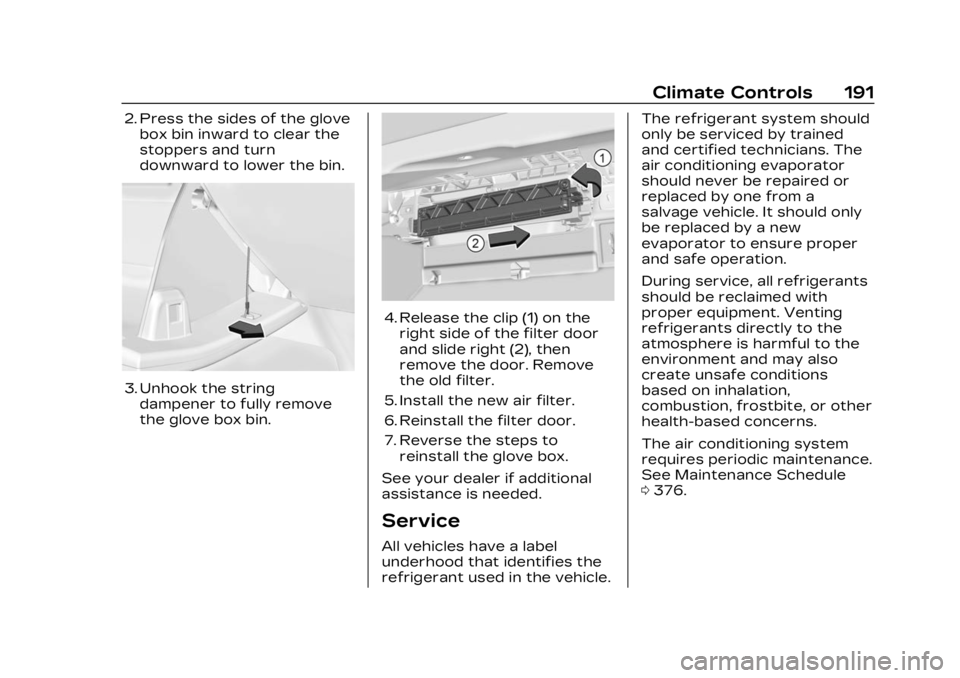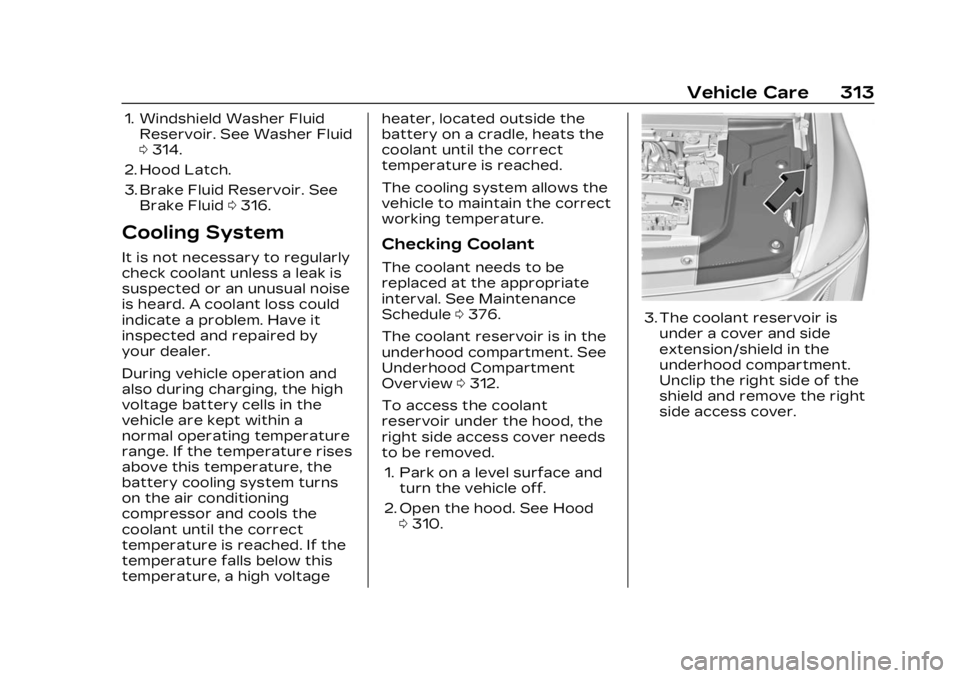2023 CADILLAC LYRIC air conditioning
[x] Cancel search: air conditioningPage 192 of 424

Cadillac Lyriq Owner Manual (GMNA-Localizing-U.S./Canada-15644413) -
2023 - CRC - 2/23/22
Climate Controls 191
2. Press the sides of the glovebox bin inward to clear the
stoppers and turn
downward to lower the bin.
3. Unhook the stringdampener to fully remove
the glove box bin.
4. Release the clip (1) on theright side of the filter door
and slide right (2), then
remove the door. Remove
the old filter.
5. Install the new air filter.
6. Reinstall the filter door.
7. Reverse the steps to reinstall the glove box.
See your dealer if additional
assistance is needed.
Service
All vehicles have a label
underhood that identifies the
refrigerant used in the vehicle. The refrigerant system should
only be serviced by trained
and certified technicians. The
air conditioning evaporator
should never be repaired or
replaced by one from a
salvage vehicle. It should only
be replaced by a new
evaporator to ensure proper
and safe operation.
During service, all refrigerants
should be reclaimed with
proper equipment. Venting
refrigerants directly to the
atmosphere is harmful to the
environment and may also
create unsafe conditions
based on inhalation,
combustion, frostbite, or other
health-based concerns.
The air conditioning system
requires periodic maintenance.
See Maintenance Schedule
0
376.
Page 195 of 424

Cadillac Lyriq Owner Manual (GMNA-Localizing-U.S./Canada-15644413) -
2023 - CRC - 2/23/22
194 Driving and Operating
Acceleration/Braking/
Coasting
Avoid rapid accelerations and
decelerations.
Use cruise control when
appropriate.
Plan ahead for decelerations,
and coast whenever possible.
Do not rush to traffic signals,
and do not shift to N (Neutral)
to coast.
Use the One-Pedal Driving
feature when appropriate to
help recover energy during
coasting and braking.
One-Pedal mode recovers
more energy while coasting
and braking than D (Drive)
mode. See One-Pedal Driving
0214.
Use the steering wheel Regen
on Demand paddle during
deceleration to help recover
energy. See Regenerative
Braking 0220. Terrain and Vehicle Speed
Higher speeds and grade
changes use more energy and
can significantly reduce
electric range.
Climate Setting
Using the heat and air
conditioning systems
decreases the energy
available for electric driving.
Optimal energy efficiency is
achieved when the heat, air
conditioning, and fan are
turned off.
Use the heated and ventilated
seat features (if equipped)
instead of the climate control
system. Heating and
ventilating the seat uses less
energy than heating and
cooling the interior. See
Heated and Ventilated Front
Seats
045 and
Heated Rear Seats 049.
Use the Remote Start Climate
Control feature to heat or cool
the interior while the vehicle is
plugged in to use electricity from the electrical outlet
instead of using energy from
the battery. See Remote Start
0
15.
In hot weather, avoid parking
in direct sunlight. Use
sunshades inside the vehicle.
Keep the inside of the
windows clean to reduce
fogging. Turn off the front
defroster and rear defogger
when they are not needed.
Avoid driving with the
windows open at highway
speeds.
Use the Battery Gauge on the
Instrument Cluster to view the
effect of climate control
settings on your estimated
range. See Battery Gauge
(High Voltage) 0110.
Outside Temperature
On colder days, it is best to
plug in the vehicle overnight,
and then remote start the
vehicle.
Page 314 of 424

Cadillac Lyriq Owner Manual (GMNA-Localizing-U.S./Canada-15644413) -
2023 - CRC - 2/23/22
Vehicle Care 313
1. Windshield Washer FluidReservoir. See Washer Fluid
0314.
2. Hood Latch.
3. Brake Fluid Reservoir. See Brake Fluid 0316.
Cooling System
It is not necessary to regularly
check coolant unless a leak is
suspected or an unusual noise
is heard. A coolant loss could
indicate a problem. Have it
inspected and repaired by
your dealer.
During vehicle operation and
also during charging, the high
voltage battery cells in the
vehicle are kept within a
normal operating temperature
range. If the temperature rises
above this temperature, the
battery cooling system turns
on the air conditioning
compressor and cools the
coolant until the correct
temperature is reached. If the
temperature falls below this
temperature, a high voltage heater, located outside the
battery on a cradle, heats the
coolant until the correct
temperature is reached.
The cooling system allows the
vehicle to maintain the correct
working temperature.Checking Coolant
The coolant needs to be
replaced at the appropriate
interval. See Maintenance
Schedule
0376.
The coolant reservoir is in the
underhood compartment. See
Underhood Compartment
Overview 0312.
To access the coolant
reservoir under the hood, the
right side access cover needs
to be removed. 1. Park on a level surface and turn the vehicle off.
2. Open the hood. See Hood 0310.
3. The coolant reservoir is
under a cover and side
extension/shield in the
underhood compartment.
Unclip the right side of the
shield and remove the right
side access cover.
Page 335 of 424

Cadillac Lyriq Owner Manual (GMNA-Localizing-U.S./Canada-15644413) -
2023 - CRC - 2/23/22
334 Vehicle Care
Fuses UsageF26 ECP_E_BATT 2/ ACEC & HUD/
HVAC DISPLAY –
Electrification
Control Processor
Battery 2/Air
Condition Electric
Compressor and
Heads-Up Display/
Heating,
Ventilation and Air
Conditioning
Display
F27 BCM 3 –Body
Control Module 3
F28 BCM 2 –Body
Control Module 2
F29 AMP-UPLEVEL –
Amplifier-Uplevel
F30 BCM 4 –Body
Control Module 4 Fuses Usage
F31 VPM/SD CARD/ ILSS/OHC –Video
Processing
Module/SD Card/
Indicator Light and
Solar Sensor/Over
Head Console
F32 HSWM –Heated
Steering Wheel
Module
F33 LRR FR/LIDAR –
Long Range Radar
Front/Light
Detection and
Ranging
F34 ELM 2 –Exterior
Lighting Module 2
F35 HDLP LT –
Headlamp Left
F36 VCU BATT 1 –
Virtual Cockpit
Unit Battery 1
F37 TCP (OnStar) –
Telematics
Communication
Platform Fuses Usage
F38 WCM –Wireless
Charger Module
F39 HI VOLTAGE SYS LCKOUT –High
Voltage System
Lockout
F40 VCU Batt 2 –
Virtual Cockpit
Unit Battery 2
F41 ELM 6 –Exterior
Lighting Module 6
F42 –
Wheels and Tires
Tires
Every new GM vehicle has
high-quality tires made by a
leading tire manufacturer.
See the warranty manual
for information regarding
the tire warranty and
where to get service. For
additional information refer
to the tire manufacturer.
Page 378 of 424

Cadillac Lyriq Owner Manual (GMNA-Localizing-U.S./Canada-15644413) -
2023 - CRC - 2/23/22
Service and Maintenance 377
needed if driving in areas with
heavy traffic, poor air quality,
high dust levels,
or environmental allergens.
Passenger compartment air
filter replacement may also be
needed if there is reduced
airflow, window fogging,
or odors. Your GM dealer can
help determine when to
replace the filter.
Every 161 000 km
(100,000 mi)
Replace the hood and/or body
lift support gas struts. Or
every 10 years, whichever
comes first. See Gas Strut(s)
0321.
Every 240 000 km
(150,000 mi)
Drain and fill the coolant
circuits. Or every five years,
whichever comes first. See
Cooling System 0313.Severe Conditions
Requiring More Frequent
Maintenance*
.Mainly driven in heavy city
traffic in hot weather.
.Mainly driven in hilly or
mountainous terrain.
.Frequently towing a trailer.
.Used for high speed or
competitive driving.
.Used for taxi, police,
or delivery service.
Additional Required
Services —Severe Service
Every 72 000 km (45,000 mi)
.Change electric drive unit
fluid. See Recommended
Fluids and Lubricants 0379.
Owner Checks and
Services
Every Five Years
Replace the brake fluid every
five years. See Brake Fluid
0316. Every Seven Years
Replace the air conditioning
desiccant every seven years.
This service helps the
longevity and efficient
operation of the air
conditioning system. This
service can be complex. See
your dealer.
Multi-Point Vehicle
Inspection (MPVI)
A Multi Point Vehicle
Inspection (MPVI) completed
by a GM dealer technician is a
maintenance assessment of
your vehicle. The benefit of
the MPVI is to identify and
inform the customer of service
items that require immediate
attention and those that may
require attention in the future.
The technician will perform the
following checks on your
vehicle. For a complete list of
checks, inspections, and
services, see your dealer.
Page 384 of 424

Cadillac Lyriq Owner Manual (GMNA-Localizing-U.S./Canada-15644413) -
2023 - CRC - 2/23/22
Technical Data 383
Vehicle Data
Capacities and Specifications
The following approximate capacities are given in metric and English conversions.
Refer to Recommended Fluids and Lubricants0379 for more information.
Application Capacities Metric English
Air Conditioning Refrigerant For the air conditioning system refrigerant
charge type and amount, see the refrigerant label under the hood. See your dealer for more information.
Cooling Systems* 10.8 L 11.4 qt
Wheel Nut Torque 190 Y140 lb ft
All capacities are approximate. When adding, be sure to fill to the approximate level, as
recommended in this manual. Recheck fluid level after filling.
*Cooling systems capacity values are based on the individual cooling system and its components.
Page 411 of 424

Cadillac Lyriq Owner Manual (GMNA-Localizing-U.S./Canada-15644413) -
2023 - CRC - 2/23/22
410 INDEX
IndexA
Accessories andModifications . . . . . . . . . . . . . . . . 308
Accessory Power . . . . . . . . . . . 209
Adaptive Cruise Control . . . . . . . . . . . . . . 225
ForwardLighting (AFL) . . . . . . . . . . . . . . 143
Add-On Electrical Equipment . . . . . . . . . . . . . . . . . . . 306
Additional OnStar Information . . . . . . . 402
Adjustments Lumbar, Front Seats . . . . . . . . 41
Agreements Trademarks andLicense . . . . . . . . . . . . . . . . . . . . . . 182
Air Conditioning . . . . . . . . . . . . . . . . . 185
Filter, Passenger
Compartment . . . . . . . . . . . . . . 190
Vents . . . . . . . . . . . . . . . . . . . . . . . . . . . 189
Airbag System . . . . . . . . . . . . . . . . . 59 Check . . . . . . . . . . . . . . . . . . . . . . . . . . . 72
How Does an Airbag
Restrain? . . . . . . . . . . . . . . . . . . . . . 64
Passenger Sensing System . . . . . . . . . . . . . . . . . . . . . . . . 66 Airbag System (cont'd)
What Makes an Airbag
Inflate? . . . . . . . . . . . . . . . . . . . . . . . . 64
What Will You See after an Airbag
Inflates? . . . . . . . . . . . . . . . . . . . . . . 65
When Should an Airbag
Inflate? . . . . . . . . . . . . . . . . . . . . . . . . 63
Where Are the Airbags? . . . . . . . . . . . . . . . . . . . . . . . 61
Airbags Adding Equipment to
the Vehicle . . . . . . . . . . . . . . . . . . . . 71
Passenger Status Indicator . . . . . . . . . . . . . . . . . . . . . 113
Readiness Light . . . . . . . . . . . . . . 112
Replacing System
Parts after a Crash . . . . . . . 72
Servicing Airbag-Equipped
Vehicles . . . . . . . . . . . . . . . . . . . . . . . 71
Alarm Vehicle Security . . . . . . . . . . . . . 26
Alert Lane Change . . . . . . . . . . . . . . . . 277
Rear Cross Traffic . . . . . . . . 269
Rear Pedestrian . . . . . . . . . . . 268